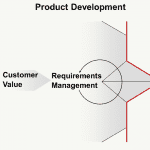
In recent articles I focused on a ‘linear’ approach to product development by understanding customer needs, establishing requirements (“what the design provides”), establishing a conceptual design, etc.
In this article, I’ll discuss a framework whereby an idea for a product or design might kick-off the process.
Also, rather than a commercialized product, we will assume our goal is to successfully demonstrate the idea’s feasibility. (This is common for a start-up company, where the business model might be to demonstrate product success with a goal of obtaining more venture capital, or to sell the intellectual property. Alternatively, a large company might want a separate idea development process that takes invention off the critical path.)
First some thoughts on ideation…
Ideation should always be encouraged, shared and built-upon. Rather than bashing an idea, ideas should be praised first with the following considerations in mind:
- What’s good about the idea? What are the good things that might result? How does it add customer value or reduce cost?
- Collaborate on key concerns, without criticizing the idea itself, ask “How might we overcome..?”
- Apply new and collaborative thinking to overcome the most critical issues.
With enough consensus an idea has potential, a project can be defined…and a certain amount of process discipline will help. Assuming our goal is a demonstration of the ideas feasibility, the phases we might follow are:
- Definition Phase – perform due diligence business and technical analysis of the identified opportunity
- Ideation Phase – identify and analyze various implementation concepts to meet customer, business and technical requirements
- Demonstration Phase – demonstrate feasibility of the selected concept(s) for meeting the customer, business and technical requirements
- Transfer to Commercialization – selected concept is incorporated into an actual product application. (The product lifecycle process for developing a commercial product can now be applied.)
Notice the process started with some ‘informal’ ideation, enough to define the project and perform some due diligence. Next, the idea can be revisited in a more extensive ‘ideation’ phase, where the idea is further developed after identifying needs, requirements, project plan, team members, etc. In addition, the outcome of the ideation phase is more than just an idea: it includes everything necessary to start investing in, and fabricating prototypes for demonstration purposes.
What is outlined herein is an ‘advanced’ development process (separate from a commercial product life cycle process)….with invention off the critical path, technology readiness is the objective and is enabled by this process.
Enabling ideas is a primary objective of any product development or process improvement process. The key is to be flexible, encourage, collaborate and integrate ideas into solutions that maximize customer value and minimize cost.
 Ask a question or send along a comment.
Please login to view and use the contact form.
Ask a question or send along a comment.
Please login to view and use the contact form.
Leave a Reply